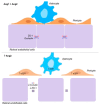Beyond VEGF: Angiopoietin-Tie Signaling Pathway in Diabetic Retinopathy
- PMID: 38792322
- PMCID: PMC11122151
- DOI: 10.3390/jcm13102778
Beyond VEGF: Angiopoietin-Tie Signaling Pathway in Diabetic Retinopathy
Abstract
Complications from diabetic retinopathy such as diabetic macular edema (DME) and proliferative diabetic retinopathy (PDR) constitute leading causes of preventable vision loss in working-age patients. Since vascular endothelial growth factor (VEGF) plays a major role in the pathogenesis of these complications, VEGF inhibitors have been the cornerstone of their treatment. Anti-VEGF monotherapy is an effective but burdensome treatment for DME. However, due to the intensive and burdensome treatment, most patients in routine clinical practice are undertreated, and therefore, their outcomes are compromised. Even in adequately treated patients, persistent DME is reported anywhere from 30% to 60% depending on the drug used. PDR is currently treated by anti-VEGF, panretinal photocoagulation (PRP) or a combination of both. Similarly, a number of eyes, despite these treatments, continue to progress to tractional retinal detachment and vitreous hemorrhage. Clearly there are other molecular pathways other than VEGF involved in the pathogenesis of DME and PDR. One of these pathways is the angiopoietin-Tie signaling pathway. Angiopoietin 1 (Ang1) plays a major role in maintaining vascular quiescence and stability. It acts as a molecular brake against vascular destabilization and inflammation that is usually promoted by angiopoietin 2 (Ang2). Several pathological conditions including chronic hyperglycemia lead to Ang2 upregulation. Recent regulatory approval of the bi-specific antibody, faricimab, may improve long term outcomes in DME. It targets both the Ang/Tie and VEGF pathways. The YOSEMITE and RHINE were multicenter, double-masked, randomized non-inferiority phase 3 clinical trials that compared faricimab to aflibercept in eyes with center-involved DME. At 12 months of follow-up, faricimab demonstrated non-inferior vision gains, improved anatomic outcomes and a potential for extended dosing when compared to aflibercept. The 2-year results of the YOSEMITE and RHINE trials demonstrated that the anatomic and functional results obtained at the 1 year follow-up were maintained. Short term outcomes of previously treated and treatment-naive eyes with DME that were treated with faricimab during routine clinical practice suggest a beneficial effect of faricimab over other agents. Targeting of Ang2 has been reported by several other means including VE-PTP inhibitors, integrin binding peptide and surrobodies.
Keywords: Tie2; angiopoietins; angiopoietin–tie pathway; diabetic macular edema; diabetic retinopathy; faricimab; retinal angiogenesis; retinal neovascularization.
Conflict of interest statement
G.C.-L., R.M.-A., A.C. and L.A.-B. declare no conflicts of interest. M.H.B. has received lecture fees from Roche, Genentech and Iveric Bio. J.A.R. has received lecture fees from ROCHE. F.J.R. has received lecture fees from Bayer, Roche and Iveric Bio. L.W. has received lecture fees from Iveric Bio, Roche, Bayer and Lumibird Medical.
Figures
References
-
- Ogurtsova K., da Rocha Fernandes J.D., Huang Y., Linnenkamp U., Guariguata L., Cho N.H., Cavan D., Shaw J.E., Makaroff L.E. IDF Diabetes Atlas: Global estimates for the prevalence of diabetes for 2015 and 2040. Diabetes Res. Clin. Pract. 2017;128:40–50. doi: 10.1016/j.diabres.2017.03.024. - DOI - PubMed
Publication types
LinkOut - more resources
Full Text Sources
Research Materials
Miscellaneous



